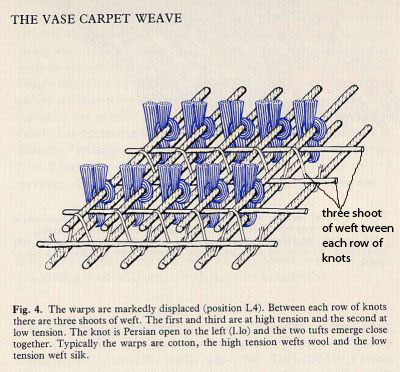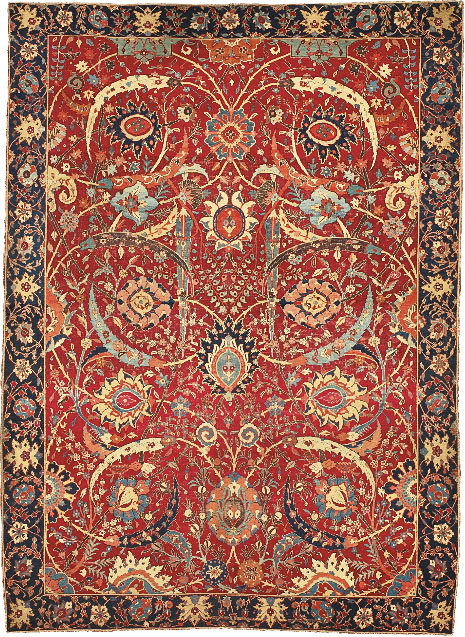According to the Little Brown Guide To Carpets in a discussion about vase rugs design and technique most “Carpets made using the vase design,… Form a definite decorative category … They are characterized by an ascending directional layout: from the bottom…pairs of very long stems, often emerging from elegant vases…”
The tiny vase in image “1” is one such “elegant” vase and the originating vase in the Clark Sickle-Leaf Carpet sold at auction for over 30 million dollars (discussed in previous post). In the middle of that carpet (image 2), down near the bottom, the vase is seen as part of that complete carpet.
But the term “vase carpet” is also applied to carpets that are woven in a special way referred to as the “vase carpet weave.” The Clark Sickle-Leaf happens to be both decoratively a vase carpet and a carpet that has been woven in the vase fashion. There are not many of them extant.
I’ve included two descriptions of the vase-rug carpet weave and the best image I could find on the web as it is difficult to wrap your mind around it without a carpet to fondle.
“There are three passes of weft after each row of knots. The first and third are of wool, which is quite tightly woven, the second or middle weft is of a sinuous pass of silk thus dividing the warps into a definite upper and lower layer. Over time the worn surfaces of the carpet show characteristic parallel warps when the second weft of silk breaks and the two planes spring apart. It is obvious that the two planes of warp allow a carpet to be densely knotted but the fine second warp, which is prone to breaking, means that there is an inherent weakness in the structure.” (from the Victoria and Albert Museum Conservation Journal, 1999)
 The second description is found at the bottom of the image but can’t be read without help. This is essentially what it says…Between each row of knots there are three shoots of weft. The first and third are at high tension and the second at low tension. The knot is Persian open to the left and the two Tufts emerge close together.
The second description is found at the bottom of the image but can’t be read without help. This is essentially what it says…Between each row of knots there are three shoots of weft. The first and third are at high tension and the second at low tension. The knot is Persian open to the left and the two Tufts emerge close together.

